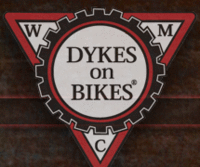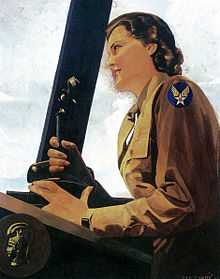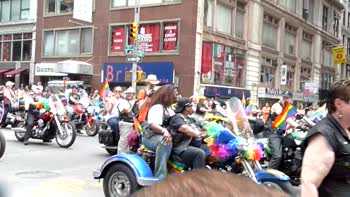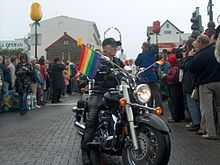Dykes on Bikes
 | |
| Founded | 4 July 1976 |
|---|---|
| Location | Chicago, Illinois |
| Founder | LB Gunn, Kalin Elliot-Arns, Christine Elliot, Sabine Balden and Mel |
| Leader | Vick Germany |
| Leader title | Road Captain/President |
| Region | USA, Canada, Australia, UK |
| Purpose | Lesbian motorcycle riders |
| Membership | 22 chapters |
| Website |
dykesonbikes |
| Abbreviation | DOB |

Dykes on Bikes (DOB) is a chartered lesbian motorcycle club with 22 chapters[1] and numerous affiliations.[2] They are known for their participation in gay pride events such as Pride parades, and significant LGBT events like the international Gay Games.[3]
They most likely were originally put at the front of the parade for logistical reasons and have remained there as a symbol of LGBT pride, defiance, liberation[4] and empowerment. The contingents are fiercely independent and self-reliant in the DIY and feminist traditions and have been studied as a social phenomenon as a "complex, multilayered form of consumption-related cultural resistance that raises awareness of social injustice and discursively informs social meanings in everyday life outside the festivals."[5]
Along with drag queens, the DOB have been criticized for not portraying a more acceptable image of LGBT culture but supporters counter that they are seen as highly visible icons of gay pride who refuse to assimilate and conform to mainstream society gender roles and indeed remind of the butches and queens who helped lead the Stonewall riots launching the modern gay-rights movement.[6]
The Dykes on Bikes have been criticized for using the term dyke in their name rather than lesbian but the group has registered the mark in the United States, after a battle to demonstrate that the terms diesel-dyke, bull-dyke, bull-dagger and dyke all have historically negative connotations but have been re-appropriated as self-referential terms of endearment and empowerment distinct from lesbian and indeed awards and events utilizing those names are now used by the LGBT community.[7] In keeping with the tradition of motorcyclists' rejection of the norms of middle-class, middle-America, the Dykes on Bikes teach, by example, that women can be masculine and challenge the dominant sexual and cultural expectations of what a woman is and what she can do and achieve.[7][8]
History
Although the term specifically was coined by actual dykes on bikes at the first gathering at the 1976 San Francisco Pride parade, it could have been used prior to then, but came into formal use at that time.[9] Dykes and motorcycles have been regularly intertwined in lesbian fiction[2] and the term is sometimes used derogatorily against any woman rider who isn't with a man.[10]
According to Harley-Davidson historians female riders did everything men did from long distance riding to enjoying lazy Sunday afternoon rides with friends.
World War II

As the US entered World War II in 1941, women were provided opportunities to volunteer for their country and almost 250,000 women served in the armed forces, mostly in the Women's Army Corps (WAC), two-thirds of whom were single and under the age of twenty-five.[11] Women were recruited with posters showing muscular, short-haired women wearing tight-fitting tailored uniforms.[11] Bessie Stringfield, a pioneer African-American female motorcyclist, joined a motorcycle dispatch unit of the army.[12]
Many lesbians joined the WAC to meet other women and to do men’s work.'[11][13] Few were rejected for lesbianism, and found that being strong or having masculine appearance – characteristics associated with being dykes – aided in the work as mechanics and motor vehicle operators.[11] A popular Fleischmann’s Yeast advertisement showed a WAC riding a motorcycle with the heading This is no time to be frail.[11][14] Some recruits appeared at their inductions wearing men’s clothing and their hair slicked back in the classic butch style of out lesbians of the time.[11]
Post-war many women including lesbians declined opportunities to return to traditional gender roles and helped redefine societal expectations that fed the women's, black and gay liberation movements.
First appearance
The first formal appearance of the Dykes on Bikes was in 1976 at San Francisco's Pride parade where the riders were placed first as motorcycles don't always run reliably at the walking pace of the rest of the parade and as first contingent they can move faster. Although the original group self-identified as Dykes on Bikes and they were known as such, over the years they used the Women’s Motorcycle Contingent/ Dykes on Bikes to encompass those who identified as gay, lesbian, bisexual, transgender or any of the newer gender-bending terms like femme, androgyne and boi.[15]
Worldwide phenomena

Dykes on Bikes have been leading marches such as Gay pride parades, Gay Games events and protests. "Dyke Marches" have become a popular Pride event nationwide with the Dykes on Bikes often leading the marches. The Dyke March events are generally non-commercial, often in sharp contrast to corporate-sponsored pride events, and are usually inclusive of lesbian, bi, and trans women. Leading pride parades around the world from San Francisco to Melbourne, Paris, London, Tokyo, Toronto, Vancouver, Sydney,[16] Zurich,[17] Tel Aviv, and Greece.[18]
Legal battle to register DOB as a trademark

On November 13, 2006, the Dykes on Bikes won the battle to trademark the name, having struggled since 2003 to persuade the PTO that "dyke" was not offensive to the lesbian community.[19][20] In 2005, after a prolonged court battle involving testimony on the word's changing role in the lesbian community, the Trademark Trial and Appeal Board permitted the group to register its name. In 2007, the club won a legal challenge from a male lawyer, Michael McDermott, who sued after the USPTO granted approval [21] calling the name “disparaging to men” and “scandalous and immoral.” [22] The court found that men had no grounds to be offended by the term. McDermott stated his opposition against any group associated with the annual Dyke March, which he dubbed "the Annual Illegal San Francisco Dyke Hate Riot" in which he and all men are subject to criminal attacks and civil right violations. He claimed the word dyke is associated with a "deep obsessive hatred of men and the male gender."[23]
Normally the United States Patent and Trademark Office (PTO), under Section 2(a) of the Lanham Act, will not consider registration of a proposed trademark which contains a term that is disparaging to a group of people. This presents a problem for the PTO when an attempt is made by a group to register a mark containing a self-disparaging term, as was done with DOB.[24] "On February 20, 2004, the PTO refused the registration of the mark 'Dykes on Bikes' under Trademark Act Section 2(a), explaining that a reasonable person of ordinary sensibilities would recognize that the term “dyke” is disparaging and objectionable to lesbian, gay, bisexual and transgender communities."[7]
However, the defense noted that during the time period from 2000-2005 the PTO had approved marks for “Crippled Old Biker Bastards,” “Biker Bitch,” “Whore,” and “Evil Pussy” as well as “TechnoDyke,” "Homo Depot," "Queer Shop," Queer Eye for the Straight Guy and Queer as Folk.[7][25] The Brooke Oliver Law Office that represented the SFWMC also pointed out the absurdity of the initial rejection ruling citing the PTO's own regulations that "the perceptions of the general public are irrelevant" and indeed the test of “whether a mark is disparaging and/or offensive is the perceptions of the individuals referred to and/or identified by that mark. In this particular case, it is women – or more specifically lesbians, bisexuals and transgender women – who ride motorcycles in the Pride Parades and who would be using the term.”[7][26]
See also
- Gay slang
- Lesbian American history
- Queer
References
- ↑ "Official website: Chapters".
- ↑ 2.0 2.1 Boslaugh, Sarah (March 2006). "Getting Past the Stereotypes: Women and Motorcycles in Recent Lesbian Novels". International Journal of Motorcycle Studies. Retrieved 2007-08-20.
- ↑ Rowe, David; Kevin Markwell; Deborah Stevenson (July 2006). "Exploring participants' experiences of the Gay Games: intersections of sport, gender and sexuality". International Journal of Media and Cultural Politics 2 (2): 149. doi:10.1386/macp.2.2.149/1. Retrieved 2007-08-19.
- ↑ O'Brien, Jodi. "Changing The Subject". Echo NYC. Archived from the original on 2007-07-06. Retrieved 2007-08-18.
- ↑ Kates (Monash University), Steven M.; Russell W. Belk (University of Utah) (2001). "The Meanings of Lesbian and Gay Pride Day: Resistance through Consumption and Resistance to Consumption". Journal of Contemporary Ethnography(Sage Publications) 30 (4): 392–429. doi:10.1177/089124101030004003. Retrieved 2007-08-18.
- ↑ Gluckman, Amy; Betsy Reed (1997). Homo Economics: Capitalism, Community, and Lesbian and Gay Life. Routledge. ISBN 978-0-415-91379-9. Retrieved 2007-08-19.
- ↑ 7.0 7.1 7.2 7.3 7.4 Ilyasova, K. Alex (November 2006). "Dykes on Bikes and the Regulation of Vulgarity". International Journal of Motorcycle Studies. Retrieved 2007-08-21.
- ↑ Epstein, Debbie; Richard Johnson (1998). "Schooling Sexualities". Buckingham: Open University Press. p. 19. Retrieved 2007-08-21.
- ↑ "LGBT Pride: SF Historical Timeline". KQED.org website. Retrieved 2006-01-13.
- ↑ Slawinski, Kris (March 2006). "Motorcycles as Political". International Journal of Motorcycle Studies. Retrieved 2007-08-20.
- ↑ 11.0 11.1 11.2 11.3 11.4 11.5 Wolf, Sherry (September–October 2004). "The Roots of Gay Oppression: The Second World War" (37). International Socialist Review. Retrieved 2007-08-22.
- ↑ "Explore The History: Bessie Stringfield". Harley-Davidson. 2001. Retrieved August 22, 2007.
- ↑ Berube, Allan (1 April 2000). Coming Out Under Fire. Simon and Schuster. p. 30. ISBN 978-0-7432-1071-3.
- ↑ Berube, Allan (1 April 2000). Coming Out Under Fire. Simon and Schuster. ISBN 978-0-7432-1071-3.
- ↑ "Dykes on Bikes". SF Women's Motorcycle Contingent Dykes on Bikes website. Retrieved 2006-01-13.
- ↑ "Lesbian bike brigade demands trademark for club name". Pakistan Daily Times. 2005-07-28. Retrieved 2007-08-21.
- ↑ "Warmer Mai Gay Festival". What's On When. 2007. Retrieved 2007-08-21.
- ↑ "Sapphite Links, Groups & Communities". Sapphites in Greece. 2006-07-30. Retrieved 2007-08-21.
- ↑ Raab, Barbara (2006-04-20). "Dyke Drama: A not-so-excellent adventure through U.S. trademark law". American Sexuality magazine (National Sexuality Resource Center). Retrieved 2007-03-17.
- ↑ National Center for Lesbian Rights (2006). "What's in a Name?". NCLR Newsletter 2006 (Winter): p. 1.
'On November 13th, the Women's Motorcycle Contingent formally won the legal right to trademark "DYKES ON BIKES."
- ↑ McDermott vs. San Francisco Women's Motorcycle Contingent, 07-7126.
- ↑ "Court rules Dykes on Bikes are not offensive, Pink News, 16 July 2007". Pinknews.co.uk. Retrieved 2013-12-04.
- ↑ Man has no legal grounds for objecting to 'Dykes on Bikes,' court says. Marisa Lagos, San Francisco Chronicle, Thursday, July 12, 2007
- ↑ Anten, Todd (2006). "Self-Disparaging Trademarks and Social Change: Factoring the Reappropriation of Slurs into Section 2(a) of the Lanham Act". Columbia Law Review 106: 338. Archived from the original on November 24, 2006. Retrieved 2007-07-12.
- ↑ Cincone, Gia (2005-09-15). ""Exhibit A." Applicant’s Request to Remand for Additional Evidence, Part I". Townsend and Townsend & Crew LLP. Retrieved 2007-08-21.
- ↑ Oliver, Brooke (August 2004). ""Response to Office Action." Response to USPTO’s Initial Refusal. Brooke Oliver Law Group, P.C. 20". Brooke Oliver Law Group. Retrieved 2007-08-21.
Further reading
- Joans, Barbara. 1995. "Dykes on Bikes Meet Ladies of Harley." In William L. Leap (ed.), Beyond the Lavender Lexicon: Authenticity, Imagination and Appropriation in Lesbian and Gay Languages. New York: Gordon and Breach Press. Pp. 87–106.
External links
| Wikimedia Commons has media related to Dykes on Bikes. |
- Dykes on Bikes at the 2011 San Francisco Pride parade
- Dykes on Bikes at the Open Directory Project
- Dykes on Bikes, Melbourne, Australia

